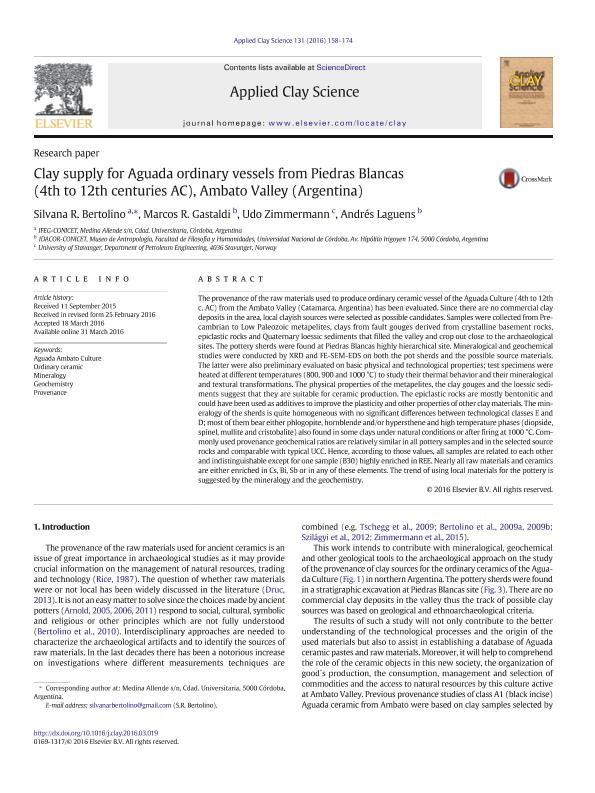Mostrar el registro sencillo del ítem
dc.contributor.author
Bertolino, Silvana Raquel Alina

dc.contributor.author
Gastaldi, Marcos Roman

dc.contributor.author
Zimmermann, Udo

dc.contributor.author
Laguens, Andres Gustavo

dc.date.available
2018-10-17T17:46:54Z
dc.date.issued
2016-10
dc.identifier.citation
Bertolino, Silvana Raquel Alina; Gastaldi, Marcos Roman; Zimmermann, Udo; Laguens, Andres Gustavo; Clay supply for Aguada ordinary vessels from Piedras Blancas (4th to 12th centuries AC), Ambato Valley (Argentina); Elsevier Science; Applied Clay Science; 131; 10-2016; 158-174
dc.identifier.issn
0169-1317
dc.identifier.uri
http://hdl.handle.net/11336/62577
dc.description.abstract
The provenance of the raw materials used to produce ordinary ceramic vessel of the Aguada Culture (4th to 12th c. AC) from the Ambato Valley (Catamarca, Argentina) has been evaluated. Since there are no commercial clay deposits in the area, local clayish sources were selected as possible candidates. Samples were collected from Precambrian to Low Paleozoic metapelites, clays from fault gouges derived from crystalline basement rocks, epiclastic rocks and Quaternary loessic sediments that filled the valley and crop out close to the archaeological sites. The pottery sherds were found at Piedras Blancas highly hierarchical site. Mineralogical and geochemical studies were conducted by XRD and FE-SEM-EDS on both the pot sherds and the possible source materials. The latter were also preliminary evaluated on basic physical and technological properties; test specimens were heated at different temperatures (800, 900 and 1000 °C) to study their thermal behavior and their mineralogical and textural transformations. The physical properties of the metapelites, the clay gouges and the loessic sediments suggest that they are suitable for ceramic production. The epiclastic rocks are mostly bentonitic and could have been used as additives to improve the plasticity and other properties of other clay materials. The mineralogy of the sherds is quite homogeneous with no significant differences between technological classes E and D; most of them bear either phlogopite, hornblende and/or hypersthene and high temperature phases (diopside, spinel, mullite and cristobalite) also found in some clays under natural conditions or after firing at 1000 °C. Commonly used provenance geochemical ratios are relatively similar in all pottery samples and in the selected source rocks and comparable with typical UCC. Hence, according to those values, all samples are related to each other and indistinguishable except for one sample (B30) highly enriched in REE. Nearly all raw materials and ceramics are either enriched in Cs, Bi, Sb or in any of these elements. The trend of using local materials for the pottery is suggested by the mineralogy and the geochemistry.
dc.format
application/pdf
dc.language.iso
eng
dc.publisher
Elsevier Science

dc.rights
info:eu-repo/semantics/openAccess
dc.rights.uri
https://creativecommons.org/licenses/by-nc-nd/2.5/ar/
dc.subject
Aguada Ambato Culture
dc.subject
Geochemistry
dc.subject
Mineralogy
dc.subject
Ordinary Ceramic
dc.subject
Provenance
dc.subject.classification
Historia

dc.subject.classification
Historia y Arqueología

dc.subject.classification
HUMANIDADES

dc.title
Clay supply for Aguada ordinary vessels from Piedras Blancas (4th to 12th centuries AC), Ambato Valley (Argentina)
dc.type
info:eu-repo/semantics/article
dc.type
info:ar-repo/semantics/artículo
dc.type
info:eu-repo/semantics/publishedVersion
dc.date.updated
2018-10-17T17:02:44Z
dc.journal.volume
131
dc.journal.pagination
158-174
dc.journal.pais
Países Bajos

dc.journal.ciudad
Amsterdam
dc.description.fil
Fil: Bertolino, Silvana Raquel Alina. Consejo Nacional de Investigaciones Científicas y Técnicas. Centro Científico Tecnológico Conicet - Córdoba. Instituto de Física Enrique Gaviola. Universidad Nacional de Córdoba. Instituto de Física Enrique Gaviola; Argentina
dc.description.fil
Fil: Gastaldi, Marcos Roman. Consejo Nacional de Investigaciones Científicas y Técnicas. Centro Científico Tecnológico Conicet - Córdoba. Instituto de Antropología de Córdoba. Universidad Nacional de Córdoba. Facultad de Filosofía y Humanidades. Instituto de Antropología de Córdoba; Argentina
dc.description.fil
Fil: Zimmermann, Udo. University of Stavanger; Noruega
dc.description.fil
Fil: Laguens, Andres Gustavo. Consejo Nacional de Investigaciones Científicas y Técnicas. Centro Científico Tecnológico Conicet - Córdoba. Instituto de Antropología de Córdoba. Universidad Nacional de Córdoba. Facultad de Filosofía y Humanidades. Instituto de Antropología de Córdoba; Argentina
dc.journal.title
Applied Clay Science

dc.relation.alternativeid
info:eu-repo/semantics/altIdentifier/doi/http://dx.doi.org/10.1016/j.clay.2016.03.019
dc.relation.alternativeid
info:eu-repo/semantics/altIdentifier/url/https://www.sciencedirect.com/science/article/pii/S016913171630120X
Archivos asociados
